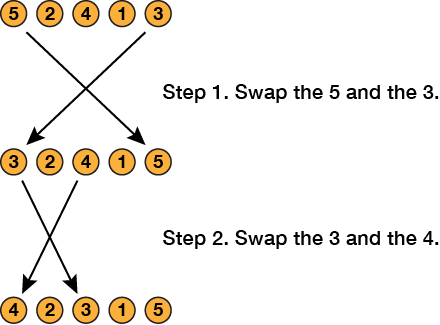There are two fundamentally different ways that we understand numbers, namely as cardinals and ordinals. When we think of a number as magnitude or size, that's a cardinal number. When order and sequence are the things we want, then we are dealing with ordinal numbers.
In a previous post I related how I handle ordinal numbers more easily than ordered sequences of other things (like the English alphabet). I thought it might be interesting to create a couple of puzzles that deal with ordinal numbers.
Here are three puzzles that are intended for children in the elementary grades, but they can be scaled up to higher levels. The first two are quite new (but I recently discovered a version of the first one in Kordemsky's "Moscow Puzzles". The third puzzle is one from a small set that I made up over 15 years ago.
Each puzzle asks you to rearrange a set of numbered disks (or tiles) so that they are in numerical order. What makes the puzzles a challenge is that there are restrictions on how you can move the disks.
Swap positions 1
For this puzzle you require five disks numbered 1 though 5. Place them in a line in random order:
The puzzle is to rearrange the numbers so that they are in order:
Rules:
- You must solve the puzzle in a step by step fashion.
- For each step you must swap the positions of two numbers.
Here are two possible steps for the puzzle above. (Not saying that these steps are part of the solution.)
You always have to swap two numbers. You are not allowed to squeeze one number between two others like this:
Small Spoiler: (Use your mouse to select the hidden text in the following box.)
With these rules, the solver may soon figure out that you can swap two numbers that are next to each other and successively move a number up and down the line (thereby inventing an algorithm that solves the puzzle).
Swap Positions 2
Let's adjust the rules and make it just a bit more difficult. And because it is more challenging, try it using four numbers instead of five.
New Rules:
- You must solve the puzzle in a step by step fashion.
- For each step you must swap the positions of two numbers.
- The two numbers must have at least one other number between them.
This is what you can and cannot do under the new rules:
Some other modifications are suggested at the end of this post.
The criss-cross puzzle
Place the tiles in the grid in the order 3-2-1 from left to right. By pushing the tiles within the grid, rearrange them so that they are ordered 1-2-3 from left to right. The tiles must end up in the position shown.
Rules:
- The tiles must always move and stay inside the grid.
- You can push tiles up, down, left, or right as long as you stay inside the grid. You cannot push a tile past, or over, or under another tile.
- If two or more tiles are touching you can push them together at the same time.
- You cannot separate tiles that are touching by pulling them apart in the same line.

This move is OK. Here, the three tiles have together been pushed to the left.

This move is OK. You can push a tile up or down as long as it stays inside the grid.

But this move is Not OK. You are not allowed to pull tiles apart in the same line if they are touching.
You can also try the puzzle with different starting positions:
Note: Depending upon the student(s), you might want to prepare them for the puzzle by letting them get familiar with moving the tiles. For example, have them figure out how to solve the following puzzle which only asks them to switch the position of the red tile. It's an interesting puzzle in its own right. The rules for moving the tiles are the same.
What if we change the rules so that you are only allowed to swap numbers if they have at least two numbers between them? What other modifications could you make for the puzzle?
You can extend the criss-cross puzzle (to include more tiles) by changing the playing board. Here are two possibilities. The rules remain the same.
Computer science students: Can you write a program that solves these puzzles?
Possible modifications
Both swap positions puzzles can be solved for any set of numbers, e.g.,What if we change the rules so that you are only allowed to swap numbers if they have at least two numbers between them? What other modifications could you make for the puzzle?
You can extend the criss-cross puzzle (to include more tiles) by changing the playing board. Here are two possibilities. The rules remain the same.
Computer science students: Can you write a program that solves these puzzles?











No comments:
Post a Comment